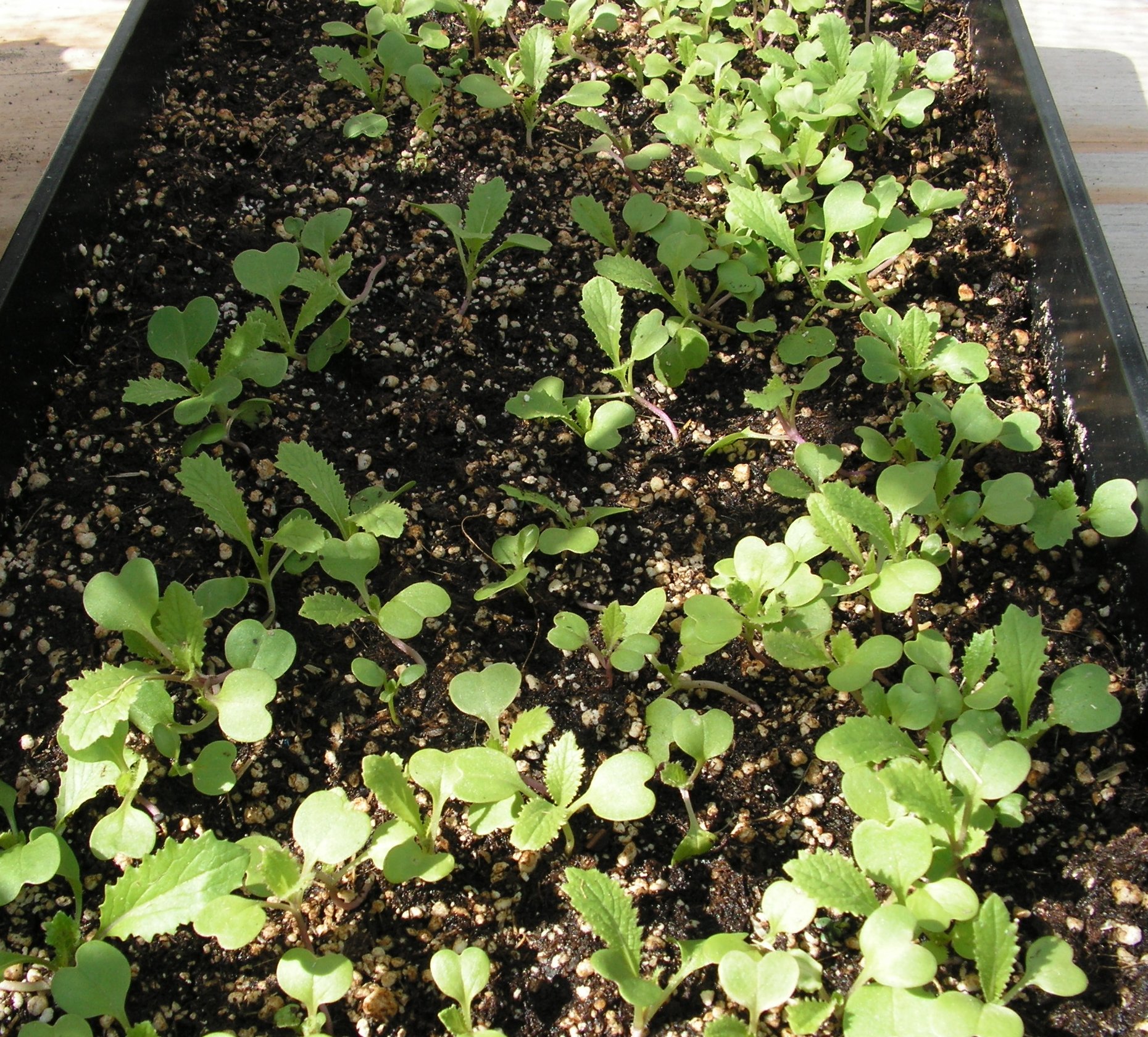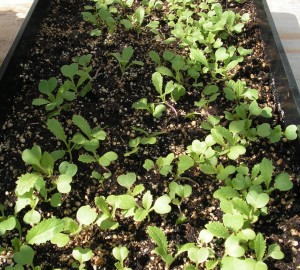Starting seeds yourself will give you a much wider variety of choices, but depending upon the plant and the time of year, you may not be able to start all your plants from seed. Naturally this depends upon your location and climate, and when you actually get started. Should you determine you need to purchase seedlings, take a look at our Sources for Seedlings article.
It is possible to start plants out of doors even in cooler climates a few weeks ahead of the last frost dates by using cold frames or creating protected areas in the warmest areas of the garden for seed starts. Should you be a couple of months ahead of the last frost date, you’ll have time to plant vegetables like tomatoes, eggplant, peppers, cabbages, and the other popular members of the brassica family indoors and move them out of doors when the weather turns warmer.
Tip: Most brassicas, such as cabbage, broccoli, cauliflower, Brussels sprouts, kohlrabi, as well as spinach, Swiss chard, onions, carrots and peas can all go into the ground up to a month before the last frost date. Peas actually do well even as early as six to eight weeks ahead of the last frost. Should you have excessive Spring rains you may need to shelter them under a simple hoop, plastic or glass to avoid them getting too water-logged. If you’re planting seed and it’s very wet, just lay a sheet of plastic over the ground where you plant if it’s very rainy, or use a piece of burlap if it’s just windy with moderate rain to keep the seeds from washing or blowing away. Remove these covers as soon as the seeds sprout. Should it still be very wet, raise the sheet or form a little tent or mini hoop over the seedlings until the weather gets a bit drier.
Perhaps the most critical part of getting the most out of a vegetable garden is correct timing of the planting of the vegetables. Cool weather crops planted too late in the season will come up fine and then bolt (go to seed) before you get a good crop. Warm weather crops will rot in the ground if planted too early and will never get to ripen if planted too late.
Many new gardeners make mistakes in this area. The two most common mistakes are starting seedlings indoors too early and transplanting seedlings out in the garden too soon. That human impatience is showing here! As someone who is perennially impatient, I know this syndrome all too well.
So, how do you know when to start seedlings and when to plant out transplants? The answer depends on the vegetable, and the date of the last frost in your area. You can adapt your methods, as mentioned above with covers and cold frames to get a jump start.
Common Mistakes of the Impatient Gardener
1. Plants started too early indoors grow leggy and weak. They make poor transplants and do not adjust to the transplanting well, going weak and flaccid rather than strong and vigorous.
2. Plants that are transplanted out too early may very well rot in the ground rather than grow; this is particularly true of the warm weather crops such as squashes, tomatoes, peppers, gourds, eggplants or any of the heavy fruit producing plants. Generally speaking they are all warm weather crops and want a soil that is over 50 degrees. A good rule of thumb is to wait at least one to two weeks after the last frost date for your area: If you are cold while working in the garden, it is too cold to plant these warm weather crops.
When to start plants indoors for outdoor transplanting
Cool Weather Crops can go in the ground either ahead of or just at the date of last frost.
Warm weather crops need warm soil and should wait until at least 2 weeks after last frost in most cases. Wait until the soil is warm to the touch. Raised beds and pulling back mulches can speed up the warming of the soil.
The Warm Weather Planting Crops
Tomatoes, sweet peppers, eggplants, potatoes, garden huckleberry, caribbean red hot peppers, chili pepper, habanero, hot paper lantern paprika, tomatillo/husk cherry melons, squashes, cucumbers, gourds, celery, celeriac, sunflower, tarragon, marjoram, caraway, coriander/cilantro, cumin, most beans, corn, turnips, parsnips.
The Cool Weather Crops
Peas, carrots, lettuce, parsley, swiss chard, spinach, bok choi, broccoli, broccoli raab, brussels sprouts, cabbage, calabrese, cauliflower, chinese cabbage, collards, cress, daikon, horseradish, kale, kohlrabi, mustard, radish, rutabaga, swede, tatsoi, turnip, wasabi, watercress onion, garlic, dill, cilantro, fennel, chervil.
The Early Starters for Indoor Planting
Specific members of these two groups are started indoors early for two different reasons: Tomatoes, peppers and eggplants take longer to germinate and develop to a size ready for the garden. Broccoli, cabbages, cauliflowers, and other large body brassicas will move a little faster, but they can be planted ahead of the last frost date, or just as it hits.
Two tips to keep in mind: If your seedlings are looking leggy and spindly, they need more light. If you have a greenhouse, this usually is not the problem, as the days are getting longer throughout the sprouting process. If not, a sunny south window usually is fine, but lacking these, a fluorescent light hung over the plants (it can almost touch them as fluorescent lights are not hot) should solve the problem. The other issue with indoor seedlings is strength that normally builds from a light breeze out of doors is missing, so either set up a cheap fan or simply brush your hands over the seedlings at least twice a day to simulate wind movement. It will make their stems stronger.
The Later Starters for Indoor Planting
Now for the second group of indoor seedlings, the squashes, cucumbers, and really warm weather family, cucurbits. These should not be started more than four weeks prior to last frost as they will definitely get too leggy and can grow spindly fast once they are set and ready to go. These plants typically make a run for it once they hit a certain size and if they are still confined to the indoors this can be problematic. So don’t start too soon with these, even though you may be tempted.
Plants started directly from seeds are another matter altogether and have a range depending on the plant as to when they get sown in the garden. Most direct seed plants do best if not started indoors, although even these can be indoor sown if handled correctly and transplanted out before they become root bound.
The main thing with the direct seed group is that they do not like having their roots disturbed and many failed transplantings will result if the roots are separated from the soil during transplanting. To avoid this you can sow in peat pots or rolled newsprint/paper rolls with soil fillings so long as the entire pot or container is sown into the garden and so long as you do so before the roots begin to protrude from the pot or container.
Gourds are extremely sensitive to this, and will actually just die as soon as you transplant them if you disturb the roots, so never start them in seedling flats, always start them in pots that can be dug right into the garden. There is nothing more disheartening than watching a beautiful strong seedling you’ve raised for weeks simply keel over and die before your eyes when you transplant it.
For a good reference guide to planting dates for your area, go to the Farmer’s Almanac page for best planting dates, and insert your ZIP code or City, State information (if not pre-filled already) to get your local dates.



